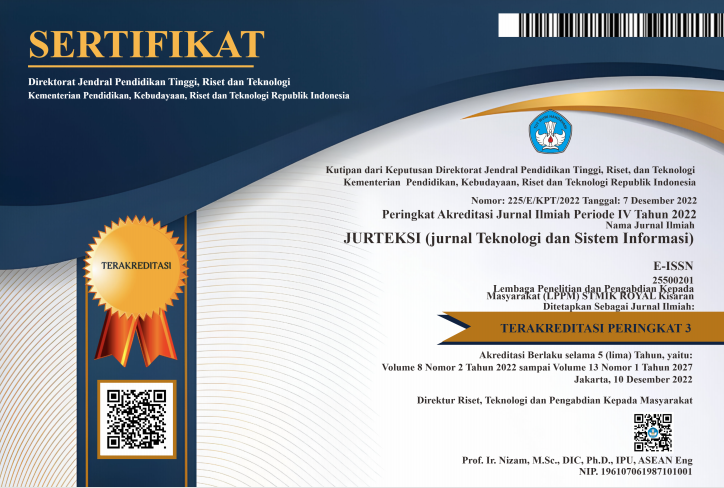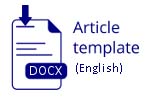A META-SYNTHESIS OF VIRTUAL REALITY IN LEARNING IN INDONESIA
Abstract
Abstract: This research was conducted in the form of a literature study. This study investigates the use of Virtual Reality (VR) in teaching, including VR methods and their application to learning. In the literature study, the database used comes from Garuda (Garuda Digital Reference), published by The Ministry of Education, Culture, Research, and Technology. The results of the literature study obtained data that 157 articles discuss the use of VR in learning from 2012 - 2022 and in the majority of VR development using the 3D Modeling method, as much as 43%. Overall, using VR in learning provides positive results that can improve learning outcomes. Three essential things must be considered in the development of VR, namely: (1) the cost of operating VR technology, (2) Accessibility that makes it easy for teachers and respondents to access the technology, (3) Setting up a virtual environment to create a practical learning experience for respondents.
Keywords: development; learning; virtual reality.
Abstrak: Penelitian ini dilakukan dalam bentuk studi literatur. Dalam penelitian ini, menyelidikan penggunaan VR dalam pembejaran, meliputi metode VR yang digunakan dan penerapannya pada pembelajaran. Dalam studi literature, basis data yang digunakan berasal dari Garuda (Garuda Rujukan Digital) yang dipublikasi oleh The Ministry of Education, Culture, Reseach, and Technology. Dari hasil studi literature diperoleh data bahwa terdapat 157 artikel yang membahas tentang penggunaan VR dalam pembelajaran dari tahun 2012 – 2022. Secara mayoritas pengembangan VR dengan menggunakan metode 3D Modelling, sebanyak 43%. Secara keseluruhan penggunaan VR dalam pembelajaran memberikan hasil yang positif dapat meningkatkan hasil belajar. Terdapat tiga hal penting yang harus diperhatikan dalam pengembangan VR, yaitu: (1) biaya pengoperasian teknologi VR, (2) Aksesibilitas yang memudahkan pengajar dan responden untuk mengakses teknologi tersebut (3) Menyiapkan lingkungan maya (virtual environment) agar menciptakan pengalaman belajar yang efektif bagi responden.
Kata kunci: pembelajaran; pengembangan; virtual reality
References
A. Saputra, “Pendidikan Dan Teknologi: Tantangan Dan Kesempatan,†Indones. J. Islam. Educ. Manag., vol. 3, no. 1, pp. 21–33, 2020.
J. Code, R. Ralph, and K. Forde, “Pandemic designs for the future: perspectives of technology education teachers during COVID-19,†Inf. Learn. Sci., vol. 12, no. 5/6, pp. 419–431, 2020.
A. Szymkowiak, B. Melović, M. Dabić, K. Jeganathan, and G. S. Kundi, “Information technology and Gen Z: The role of teachers, the internet, and technology in the education of young people,†Technol. Soc., vol. 65, p. 101565, 2021.
R. A. Ellis and A. M. Bliuc, “Exploring new elements of the student approaches to learning framework: The role of online learning technologies in student learning,†Act. Learn. High. Educ., vol. 20, no. 1, pp. 11–24, 2019.
Y. C. J. Wu, T. Wu, and Y. Li, “Impact of using classroom response systems on students’ entrepreneurship learning experience,†Comput. Human Behav., vol. 92, pp. 634–645, 2019.
L. Yan, A. Whitelockâ€Wainwright, Q. Guan, G. Wen, D. GaÅ¡ević, and G. Chen, “Students’ experience of online learning during the COVIDâ€19 pandemic: A provinceâ€wide survey study,†Br. J. Educ. Technol., vol. 52, no. 5, pp. 2038–2057, 2021.
J. Singh, K. Steele, and L. Singh, “Combining the best of online and face-to-face learning: Hybrid and blended learning approach for COVID-19, post vaccine, & post-pandemic world,†J. Educ. Technol. Syst., vol. 50, no. 2, pp. 140–171, 2021.
D. Surani, “Teknologi memungkinkan siswa untuk mengakses informasi dari sumber yang berbeda dengan lebih mudah dan cepat, seperti melalui internet atau aplikasi pendidikan,†in Prosiding Seminar Nasional Pendidikan FKIP, 2019, pp. 456–469.
A. Latip, “Peran literasi teknologi informasi dan komunikasi pada pembelajaran jarak jauh di masa pandemi Covid-19,†EduTeach J. Edukasi dan Teknol. Pembelajaran, vol. 1, no. 2, pp. 108–116, 2020.
I. H. Mu’minah and A. A. Gaffar, “Optimalisasi penggunaan google classroom sebagai alternatif digitalisasi dalam pembelajaran jarak jauh (pjj),†Bio Educ., vol. 5, no. 2, p. 378025, 2020.
R. Sipayung, D. O. Sihotang, and J. L. Batu, “Persepsi Guru terhadap Efektivitas Pembelajaran Online di Masa Pandemi Covid-19,†J. Ilm. Aquinas, vol. 4, no. 2, pp. 311–321, 2021.
L. Lailatussaadah, F. Fitriyawany, E. Erfiati, and S. Mutia, “Faktor-Faktor Penunjang Dan Penghambat Dalam Pelaksanaan Pembelajaran Daring (Online) Ppg Dalam Jabatan (Daljab) Pada Guru Perempuan Di Aceh,†Gend. Equal. Int. J. Child Gend. Stud., vol. 6, no. 2, pp. 41–50, 2020.
I. Magdalena, A. F. Shodikoh, A. R. Pebrianti, A. W. Jannah, and I. Susilawati, “Pentingnya media pembelajaran untuk meningkatkan minat belajar siswa sdn meruya selatan 06 pagi,†EDISI, vol. 3, no. 2, pp. 312–325, 2021.
S. Dhawan, “Online learning: A panacea in the time of COVID-19 crisis,†J. Educ. Technol. Syst., vol. 49, no. 1, pp. 5–22, 2020, doi: https://doi.org/10.1177/0047239520934018.
Z. Lassoued, M. Alhendawi, and R. Bashitialshaaer, “An exploratory study of the obstacles for achieving quality in distance learning during the COVID-19 pandemic,†Educ. Sci., vol. 10, no. 9, p. 232, 2020.
M. Sadeghi, “A shift from classroom to distance learning: Advantages and limitations,†Int. J. Res. English Educ., vol. 4, no. 1, pp. 80–88, 2019.
A. Bhati and I. Song, “New methods for collaborative experiential learning to provide personalised formative assessment,†Int. J. Emerg. Technol. Learn., vol. 14, pp. 179–195, 2019.
G. Alfarsi, A. B. M. Yusof, R. M. Tawafak, S. I. Malik, R. Mathew, and M. W. Ashfaque, “Instructional Use of Virtual Reality in E-Learning Environments,†in 2020 IEEE International Conference on Advent Trends in Multidisciplinary Research and Innovation (ICATMRI), 2020, pp. 1–5.
M. Mulders, J. Buchner, and M. Kerres, “A framework for the use of immersive virtual reality in learning environments,†J. Emerg. Technol. Learn., vol. 15, no. 24, pp. 208–224, 2020.
J. Tay, Y. M. Goh, S. Safiena, and H. Bound, “Designing digital game-based learning for professional upskilling: A systematic literature review,†Comput. Educ., p. 104518, 2022.
J. L. Galvan and M. C. Galvan, Writing Literature Reviews: A Guide for Students of the Social and Behavioral Sciences: Taylor & Francis, 2017.
C. V Fry, J. Lynham, and S. Tran, “Ranking researchers: Evidence from Indonesia,†Res. Policy, vol. 52, no. 5, p. 104753, 2023, doi: 10.1016/j.respol.2023.104753.
Daryono, “Pemanfaatan Photogrammetry untuk Pembelajaran Pemetaan Dasar,†J. Geod. Undip, vol. 8, no. 1, pp. 62–72, 2019.
D. Caesaron, "Reviews of Virtual Reality and Virtual Environment and It's Applications Particularly in Education," JIEMS (Journal of Industrial Engineering and Man-agement Systems)., vol 6, no. 1.
S. Sulistyowati and A. Rachman, "Pemanfaatan teknologi 3D virtu-al reality pada pembelajaran ma-tematika tingkat Sekolah Dasar," Network Engineering Research Operation, vol. 3, np. 1, pp. 37-44
B. Antero, “Media Pengenalan Hewan Liar Menggunakan Virtual Reality (VR),†J. Tek. Ilmu dan Apl., vol. 3, no. 1, pp. 1–5, 2022.
C. Mayawati, E. Ndeon, and S. Anggreinie," Integrasi Gamifikasi ke dalam Virtual Reality untuk Mewujudkan Pembelajaran Imer-sif. Jurnal LENTERA: Jurnal Studi Pendidikan, vol. 5, no. 1, pp. 91-100, 2023.
R. S. Syafril," Syafril, R. S. (2019). Penerapan Sederhana Vir-tual Reality Dalam Presentasi Ar-sitektur," NALARs, vol. 19, no. 1, pp. 29-40, 2019.
M. A. Pranata, "Game Balinese Fruit Shooter Berbasis Virtual Re-ality Sebagai Media Pembelajaran Di Taman Kanak-Kanak," EDUTECH, vol. 16, np. 3, pp. 305-324, 2018.
M. A. Pranata, G. G. Santyadiputra, and I. G. P. Sindu, “Rancangan game balinese fruit shooter berbasis virtual reality sebagai media pembelajaran,†urnal Nas. Pendidik. Tek. Inform. JANAPATI, vol. 6, no. 3, pp. 256–270, 2017.
F. H. Aminuddin and T. Djauhari, "Development Of 3d Augmanted Reality Teaching Materials Based On Virtual Technology As Learn-ing Media. Dinasti International Journal of Education Management And Social Science, vol. 2, no. 5, pp. 763-776, 2021.
E. A. Laksono and A. Susanto, "Laksono, E. A., & Susanto, A. (2020). Mathematics Education Game Using the Finite State Ma-chine Method to Implement Vir-tual Reality in Game Plat-former. Inform: Jurnal Ilmiah Bi-dang Teknologi Informasi dan Komunikasi," vol. 5, no. 1, pp. 8-13, 2020.
S. Rustiyanti, W. Listiani, F. D. Sari, and I. B. G. S. Peradantha, "Literasi tubuh virtual dalam ap-likasi teknologi Augmented Reali-ty PASUA PA," Jurnal Panggung, vol. 30, no. 3, pp. 453-464, 2020.
H. A. Musril, J. Jasmienti, and M. Hurrahman, “Implementasi Teknologi Virtual Reality Pada Media Pembelajaran Perakitan Komputer,†J. Nas. Pendidik. Tek. Inform. JANAPATI, vol. 9, no. 1, pp. 83–95, 2020.
F. H. Aminuddin and T. Djauhari, “Development Of 3d Augmanted Reality Teaching Materials Based On Virtual Technology As Learning Media,†Dinasti Int. J. Educ. Manag. Soc. Sci., vol. 2, no. 5, pp. 763–776, 2021.













